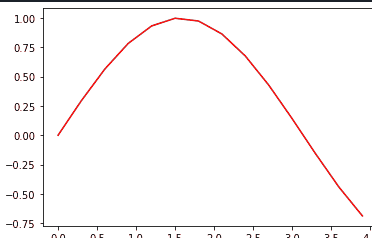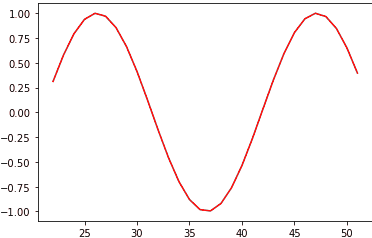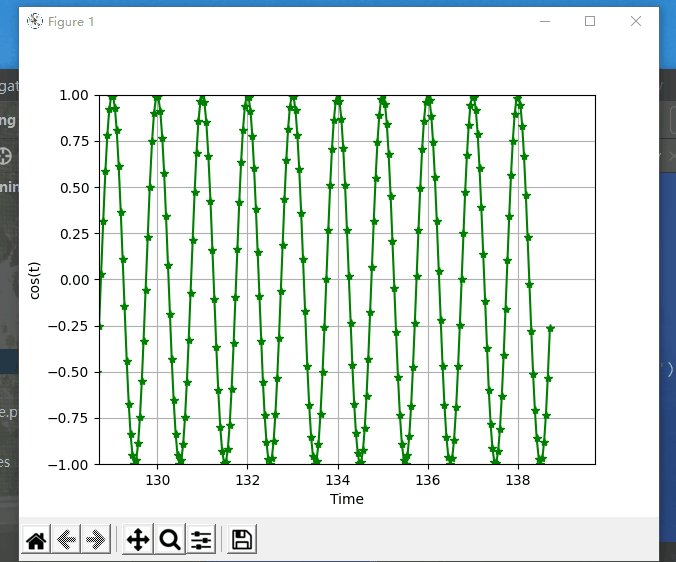您好,登录后才能下订单哦!
密码登录
登录注册
点击 登录注册 即表示同意《亿速云用户服务条款》
这篇文章主要介绍了怎么用Python显示数据图表并固定时间长度的相关知识,内容详细易懂,操作简单快捷,具有一定借鉴价值,相信大家阅读完这篇怎么用Python显示数据图表并固定时间长度文章都会有所收获,下面我们一起来看看吧。
前言:
python利用matplotlib库中的plt.ion()函数实现即时数据动态显示:
代码示例:
# -*- coding: utf-8 -*- import matplotlib.pyplot as plt import numpy as np import time from math import * plt.ion() #开启interactive mode 成功的关键函数 plt.figure(1) t = [0] t_now = 0 m = [sin(t_now)] for i in range(100): plt.clf() #清空画布上的所有内容 t_now = i*0.3 t.append(t_now)#模拟数据增量流入,保存历史数据 m.append(sin(t_now))#模拟数据增量流入,保存历史数据 plt.plot(t,m,'-r') plt.draw()#注意此函数需要调用 plt.pause(0.1)

此时间轴在不断变长。
使用队列 deque,保持数据是定长的,就可以显示固定长度时间轴的动态显示图,
代码示例:
import matplotlib.pyplot as plt
from collections import deque
from math import *
plt.ion()#启动实时
pData = deque(maxlen=30)
for i in range(30):
pData.append(0)
fig = plt.figure()
t = deque(maxlen=30)
for i in range(30):
t.append(0)
plt.title('Real-time Potentiometer reading')
(l1,)= plt.plot(pData)
plt.ylim([0, 1])
for i in range(2000):
plt.pause(0.1)#暂停的时间
t.append(i)
pData.append(sin(i*0.3))
print(pData)
plt.plot(t,pData,'-r')
plt.draw()Spyder 运行结果(貌似在pycharm 有问题)
s

偶然间看到:
import numpy as np
import matplotlib.pyplot as plt
from IPython import display
import math
import time
fig=plt.figure()
ax=fig.add_subplot(1,1,1)
ax.set_xlabel('Time')
ax.set_ylabel('cos(t)')
ax.set_title('')
line = None
plt.grid(True) #添加网格
plt.ion() #interactive mode on
obsX = []
obsY = []
t0 = time.time()
while True:
t = time.time()-t0
obsX.append(t)
obsY.append(math.cos(2*math.pi*1*t))
if line is None:
line = ax.plot(obsX,obsY,'-g',marker='*')[0]
line.set_xdata(obsX)
line.set_ydata(obsY)
ax.set_xlim([t-10,t+1])
ax.set_ylim([-1,1])
plt.pause(0.01)
关于“怎么用Python显示数据图表并固定时间长度”这篇文章的内容就介绍到这里,感谢各位的阅读!相信大家对“怎么用Python显示数据图表并固定时间长度”知识都有一定的了解,大家如果还想学习更多知识,欢迎关注亿速云行业资讯频道。
免责声明:本站发布的内容(图片、视频和文字)以原创、转载和分享为主,文章观点不代表本网站立场,如果涉及侵权请联系站长邮箱:is@yisu.com进行举报,并提供相关证据,一经查实,将立刻删除涉嫌侵权内容。